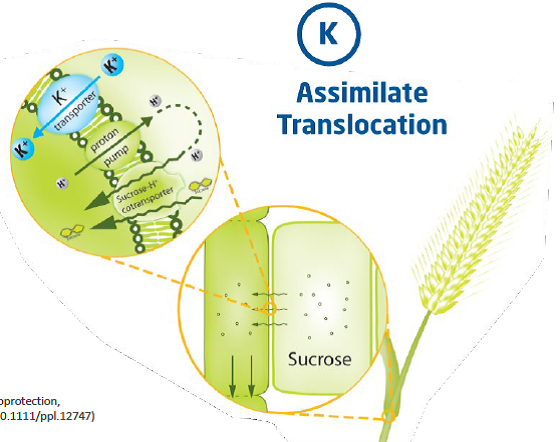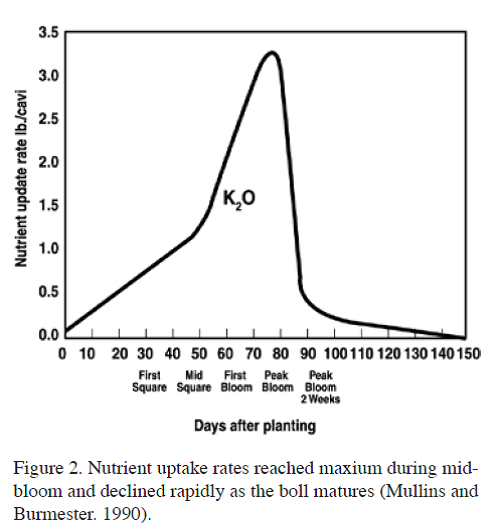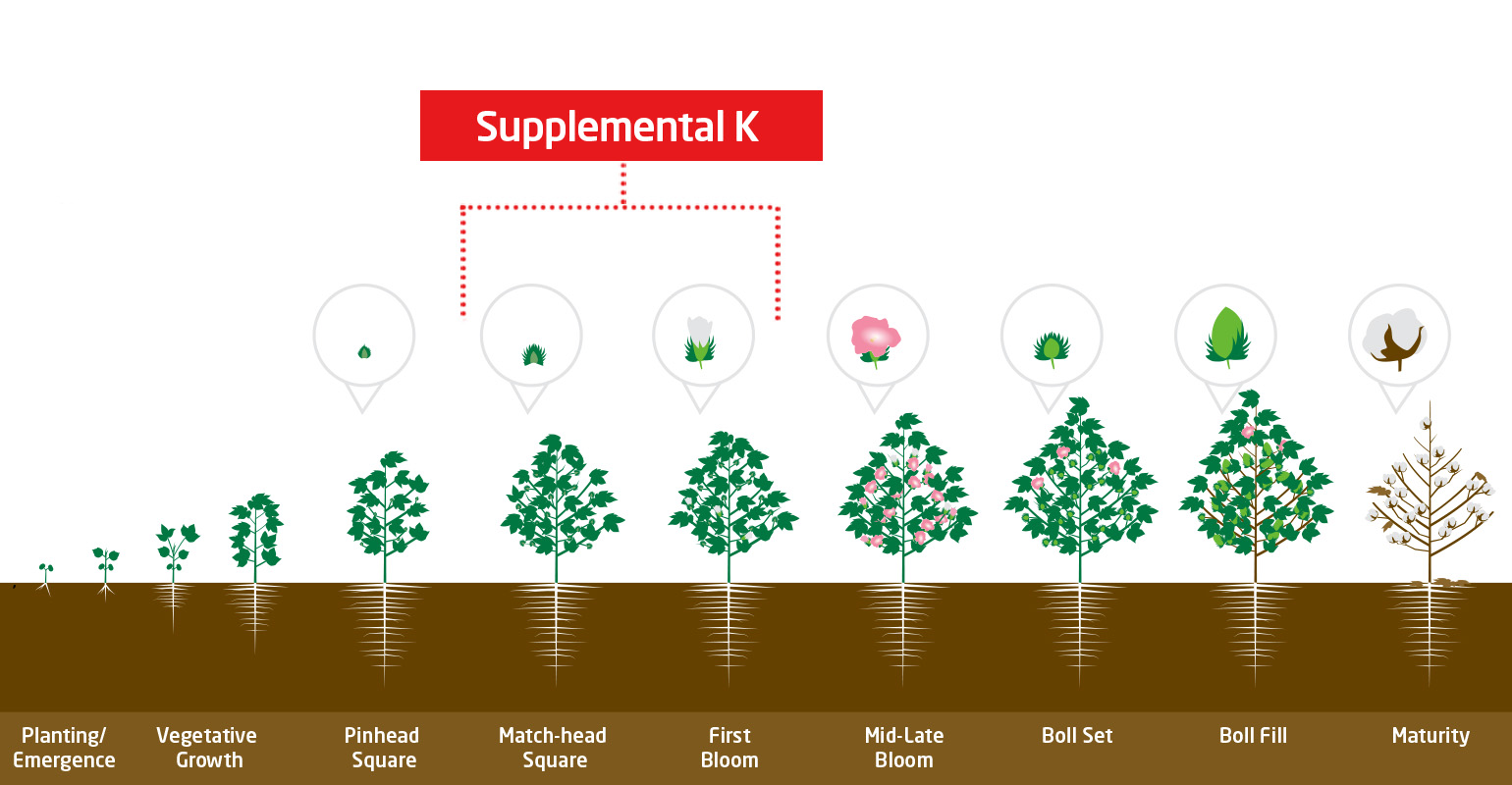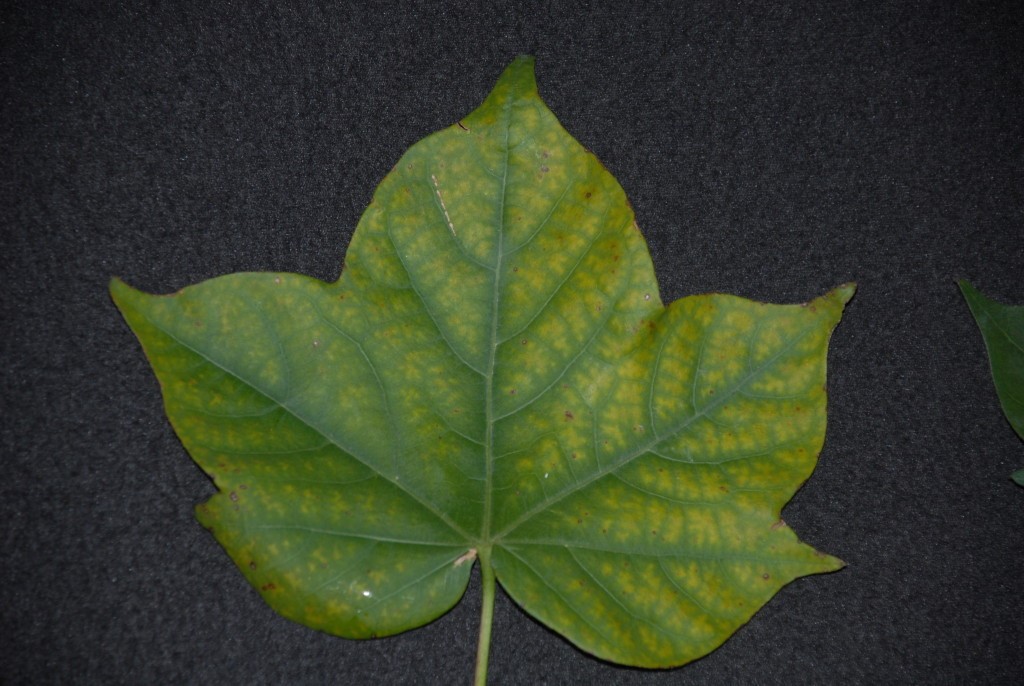Key Timings for Supplemental Potassium on Cotton
April 22, 2021
Agronomics
In cotton the high demand of fruiting structures as a sink for K is well established. In high-yielding cotton varieties, as much as ¾ of the K is partitioned to fruiting structures (bolls). Potassium (K) has a key role in fiber quality and strength, which is not surprising since it is the most abundant mineral nutrient in fibers. Most of the carbohydrate for fiber cellulose synthesis comes from the leaves subtending the cotton bolls. K deficiency affects cotton leaf photosynthetic capacity by inhibiting carbohydrate synthesis and the carbohydrate transportation rate. Therefore, K deficiency affects cotton fiber properties by inducing a carbohydrate acquisition difficulty represents a good entry point for exploring the mechanisms underlying this process.
If making a supplemental K application, one should also evaluate nitrogen (N) and boron (B) needs. N demand picks up through early flowering and is high at peak bloom. Similarly, peak demand for B occurs during flowering and extends through boll filling.
Conditions Leading to Potassium (K) Deficiencies
K mobility in soils is intermediate between N and phosphorus (P) but is not easily leached because it has a positive charge (K+), which causes it to be attracted to negatively charged soil colloids. In soils that are potassium deficient, chlorosis may be a result of this deficiency. The reason this often does not appear sooner in the season is due to cotton’s demand for K is relatively low until square appear at which time demand begins to increase.
Dry weather can cause K deficiency to appear if there is minimal moisture in the soil profile for the plant to take up water and K. In this situation you may have more than adequate soil test levels of nutrients.
Low pH soils (i.e. below 5.8) can result is restricted root growth to some degree. Restricted root growth will limit the area from which the plant can take up water and nutrients.
In some cases, a transient nutrient deficiency is caused because the plant may need more K than it can physically take up from the soil. This may be the case where cotton is blooming and is maintaining a heavy fruit load
Desired Potassium Tissue Test Values
The desired tissue test levels for youngest mature leaf are 1.5 to 3.0% K during early bloom and 0.9 to 3.0% for late bloom. In high-yielding cotton varieties it is preferred to be at the top end of sufficiency levels entering early bloom, because as much as ¾ of the K is partitioned to fruiting structures (bolls), so there is heavy draw of K moving from the leafs to developing bolls.

K are required for source to sink translocation of photoassimilates. They have important functions in apoplastic phloem loading of sucrose.

Key Application Timings and Rates
To maximize the effectiveness of supplemental K application it is important to make the applications during and right before peak demand. The best practice is to make applications between match-head square and early to peak bloom. Later applications effectiveness is varied and will depend on the fruit load and cotton varieties. Application options include side-dress, foliar and fertigation through flood, drip of pivots.
Key Products:

Nutrient(s) Deficiency Pictures
K deficiency often appears initially as interveinal chlorosis following by red coloration of leaf tissue on older leaves. After peak bloom, similar deficiency symptoms appear but tend to appear on new growth. If deficiency symptoms become severe enough, leaves can curl downward and/or appear thickened. In extreme cases, cotton will begin to defoliate itself due to K deficiency


K deficiencies are almost always correlated with Stemphylium leafspot, sometimes brought on by drought stress. Foliar fungicides also do not appear to be very effective on Stemphylium unless the potassium deficiency is addressed.
Under limiting soil conditions, foliar applications of K during boll fill can supplement K demand of developing bolls and reduce incidence of stephylium leafspot.

